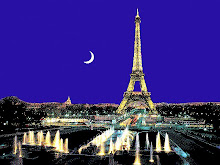Paved streets
Labels :
Paris architecture,
Stone paved streets
 The stone paved streets had more or less disappeared in Paris, but now they are again in fashion. Basically new paving is made in combination with transforming certain streets to become purely pedestrian – and that’s another nice fashion (I recently gave up my car).
The stone paved streets had more or less disappeared in Paris, but now they are again in fashion. Basically new paving is made in combination with transforming certain streets to become purely pedestrian – and that’s another nice fashion (I recently gave up my car). In history, quite a few stones have been used for other more or less revolutionary purposes, lately e.g. during the “May ‘68” manifestations.
The paving of the Paris streets started around the 12th century, in the beginning often with drains, sewers, in the middle of the street to evacuate water – and ”whatever”.
The first pedestrian pavements appeared around 1780. As from 1830, evacuation on the sides of the streets was imposed.
 Most of the streets were later – starting during the 19th century - covered first by macadam, later by bitumen, asphalt, although you can still find quite a few of the older stone paved streets and places, including Les Champs Elysées, La Place de L’Etoîle, La Place de la Concorde… It’s sometimes a bit slippery and noisy, but it’s also part of the charm.
Most of the streets were later – starting during the 19th century - covered first by macadam, later by bitumen, asphalt, although you can still find quite a few of the older stone paved streets and places, including Les Champs Elysées, La Place de L’Etoîle, La Place de la Concorde… It’s sometimes a bit slippery and noisy, but it’s also part of the charm.  You can see a sample from Les Champs Elysées here. I wonder how long these stones have been there and how many cars, motor bikes, scooters… have been rolling on them? Originally the avenue was paved in the middle of the 19th century.
You can see a sample from Les Champs Elysées here. I wonder how long these stones have been there and how many cars, motor bikes, scooters… have been rolling on them? Originally the avenue was paved in the middle of the 19th century.Pavers are still needed. No evacuation in the middle of the streets anymore!













21 comments:
Yes it amazes me all the time the unique pavement and streets too.... You are wonderful Peter to share this with us :) You are so cool :)
You hold the top of the paving stone as a blogger Peter!!
To hold the top of the paving stone (to have a good place in the company) This expression comes from the Middle Ages where the malls all were almost forms V of them so that worn water and insanities run out in the center The poorest people were to make place with the people of the nobility so that it is on the edge (thus on the highest part) furthest away from the odors.
Peter and Liliane, the good team for historical researchs! I do like to look these men at work, ""drawing" with the paving stones...but it must be a hard job. Old paving stones are in high demand and very expensive, gardeners love them in their yards...
Peter, answering to your question on yesterday: yes, many Parisians in Brittany, but those without a car seem to be more welcome ;-)
Tu m'as donné l'idée pour les pavés de Funchal dans mon blog (L6). J'aurais beaucoup à raconter sur les pavés, surtout du Nord de la France connus avec le PARIS - ROUBAIX, car comme tu le sais, mon grand père a pavé toutes ces rues.
shionge:
To start with, I learn myself, and then of course it's a pleasure to share.
lyliane:
Thanks a lot for this additionam info. I like a lot when there are comments like this. Keep learning!
alice:
Yes, I also asked myself the question about the price for these stones. I believe that they are (as a majority of things we buy today) mainly imported from China.
april:
Yes I forgot to add a word about ladies shoes. Thanks for taking care!
I read your post and found it interesting. Especially the part where you reflected on the different things that have rolled on the stones. One thing you didn't mention was the German hob-nailed boots that marched down this famous avenue during the war.
What great craftmanship in the new paving being done, I love that photo!
Peter I also wanted to thank you for your regular and always thoughtful comments on Sydney Daily Snap.
abraham:
Yes, I know that I omitted a few matters, more or less by purpose.
nathalie:
It's always a pleasure to visit your blog.
You gave up your car, Peter? Is there a Vespa in your future? ;-)
isabella:
Yes maybe a Vespa or something similar. I will probably lease one this summer, down in Provence, and test myself a little bit more before I decide.
Made in China? Or made in Brittany: you can buy many sorts of stones, paving stones, all made of Breton granite, about 3 km from my home! These ones come from here, maybe...
alice:
The old ones, on the historical sites, are most probably from Brittany, but today, I have seen somewhere that the major supplier for the standard stones used on streets rather is China.
När jag ser dessa stenläggare kommer jag att tänka på Ingemar Johansson! Han arbetade just som stenläggare i början av sitt liv.Hårt och tufft på många sätt på den tiden.Armkraft helt enkelt.
Interesting post and info. Thanks for sharing, Peter.
hogrelius:
Ingo! Som de flesta andra svenskar och speciellet göteborgare satt jag upp och lyssnade pà radio den natten han vann över Floyd Patterson! När han kom hem, var det fullsatt pà Ullevi!
ash:
A pleasure!
What more can I say? A very nice little post, Peter. Well done.
My large father was a payer in the north of France, where there is celebrates it cycle race : Paris-Roubaix, the paving stones weighed 9 kg, and it worked by all times.I drive on bicycle and to scooter on this paving stones and I often fell, because it is very slipping.
I was with the release of my country by Américan people, on this avenue Champs Elysées, I were so beautiful and smiling, that American took to mee in their arms and offered chocolate to me, but I did not have one year and half!!!
chuckeroon:
Thanks!
lyliane:
What you grandfather did was great, preparing the roads for the big sports event Paris-Roubaix, 200 km of cycling on slippery stones (it always rains during this race). Not so many of these roads left though.
Fantastic, so you were there at the Liberation!
A lot of events on the Champs Elysées; Abraham mentioned one. I remember especially being there after the 3-0 in the World Cup 1998!
it's a big jigsaw puzzle...
Les pavés sont mon dada J'en ai sur ma cheminée
Des petits pavés de Berlin
Des pavés de marbre (petits aussi) de Pragues
Un pavé de Louvain (énormes)
Dans le jardin un super gros de Pontoise
Mais celui là est neuf et à mon avis est importé de Chine
Ce que j'aime c'est qu'ils demandent un bon savoir faire pour la pose
Et ils sont recyclables comme de bien entendu
Cobbled streets are very attractive, and hard wearing if laid properly. Not so easy if you have to keep digging them up for telecom cables etc. The cobbles of the Champs-Elysee are well known to the cyclists on the last day of the Tour de France when they have to negotiate them 10 times. For cyclists they are a nightmare - especially when wet.
In Zurich we have quite a few cobbled streets but mainly in the pedestrianised areas. The tram junction at Paradeplatz used to be cobbled, but I think the maintenance efforts every time they had to relay the tramlines finally sealed their death warrant, and it's now tarmac
Post a Comment